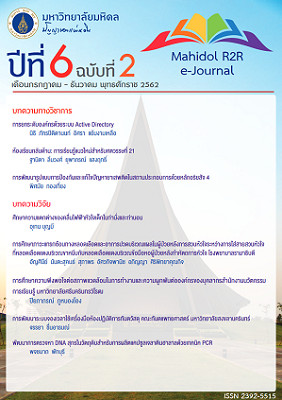พัฒนาการตรวจหา DNA สุกรในวัตถุดิบสำหรับการผลิตแคปซูลเจลาตินฮาลาล ด้วยเทคนิค PCR
DOI:
https://doi.org/10.14456/jmu.2019.16คำสำคัญ:
เจลาติน, ฮาลาล, PCRบทคัดย่อ
การระบุชนิดสัตว์ต้องห้าม เช่น เนื้อสุกรที่ปนเปื้อนในผลิตภัณฑ์อาหารเป็นสิ่งจำเป็นสำหรับการตรวจสอบอาหารฮาลาล นอกจากนี้วัตถุที่เป็นส่วนผสม เช่น เจลาติน ซึ่งเป็นส่วนผสมที่ความสำคัญในอุตสาหกรรมยาและผลิตภัณฑ์สุขภาพ การผลิตแคปซูล ต้องระบุชนิดสัตว์ เพื่อตรวจสอบการปนเปื้อนจากสัตว์ต้องห้าม ในงานวิจัยครั้งนี้มีวัตถุประสงค์เพื่อพัฒนาวิธีตรวจหาเนื้อสุกรผสมในวัตถุดิบสำหรับการผลิตแคปซูลเจลาตินฮาลาลด้วยเทคนิค Polymerase Chain Reaction (PCR) เพื่อหา primer ที่มีความไว โดยเปรียบเทียบ primer ในส่วน repetitive element และ primer ในส่วน mitochondrial DNA ตรวจหา DNA สุกรที่ไม่ได้ผ่านความร้อนและผ่านความร้อน 121 องศาเซลเซียสนาน 15 นาที พบว่าในเนื้อที่ไม่ได้ผ่านความร้อนให้ผลไม่แตกต่างกัน แต่เนื้อที่ผ่านความร้อนสูง primer ในส่วน repetitive element ให้ความไวการตรวจสอบได้ดีกว่าการตรวจสอบโดยใช้ primer ในส่วน mitochondrial DNA สามารถตรวจสอบได้ในระดับปริมาณ DNA ที่ความเข้มข้นต่ำสุดคือ 0.05% และสามารถตรวจสอบการปนเปื้อน DNA สุกรใน เจลาติน ผง แต่ primer ส่วน mitochondrial DNA สามารถตรวจสอบได้ในระดับปริมาณ DNA ที่ความเข้มข้นต่ำสุด 0.2% และให้ผลลบเมื่อตรวจสอบการปนเปื้อนสุกรจากตัวอย่างเจลาตินผง
เอกสารอ้างอิง
2. Calvo, J.H., Zaragoza, P.,and Osta, R. (2001). in processed food amplification of a new specific DNA fragment: J. Anim.Sci.2001. 79: 2108-2112.
3. Jerilyn ,A W., David, A H., Bridget A A., Jaiprakash S., Sudhir K S., and Mark, A B., (2003). Quantitative intra-short interspersed element PCR for species-specific DNA identification. Anal. Biochem. 316: 259-269.
4. Jerilyn ,A W., David, A H., Dale J H., Bridget A A., Anders M E., Jaiprakash S., Sudhir
5. K S. and Mark, A B. (2004). Quantitative PCR for DNA identification base on genome-specific interspersed repetitive element. Anal. Biochem. 83: 518-527.
6. King, N.L. and Kruth, L. (1982). Analysis of Raw beef samples for adulterant meat species by enzyme staining of isoelectric focusing gels. J Food Sci. 47(5): 1608-12.
7. Lahiff, S., Glennon, M., O’Brien, L., Lyng, J., Smith, T., Maher, M.andShilton, N. (2001). Species-specific PCR for the identification of ovine, porcine and chicken species in meta and bone meal (MBM).Mol Cell Probes.Feb; 15(1): 27-35.
8. Maharat, C., Intaraphad, U., and Jantarasamee, P., Development of pork DNA detection in meat product by PCR tecnique. Songklanakarin J. Sci. Technol., 2005, 27(5) : 993-1002
9. Matsunaga, T., Chikuni, K., Tanabe, R., Shibata, K., Yamada, T., Shinmura, Y. (1998). A quick and simple method for the identification of meat speciesand meat products by PCR assay: Meat Sci., 51: 43-148.
10. Montiel-Sosa, J.F., Ruiz-Pesini, E., Montoya, J., Roncaies, P., Lopez-Perez, M.J. and Perez-Martos, A. (2000). Direct and highly species-specific detection of pork meat and fat in meat products by PCR amplification of mitochondrial DNA. J Agric Food Chem. 48(7): 2829-32.
11. Saiki, R.K., Gelfand, D.H., Stoffel, S., Scharf, S.J., Higuchi, R., Horn, Muyllis, K.B. and Relish, H.A. (1988). Primer-directed enzymatic amplification of DNA with a thermostable DNA polymerase. Science. 239(4839): 487-91.
12. http://www.toronto.ca/health. Guide to Understanding Halal Foods is produced by Toronto Public Heaith, 2004.
ดาวน์โหลด
เผยแพร่แล้ว
ฉบับ
ประเภทบทความ
สัญญาอนุญาต




